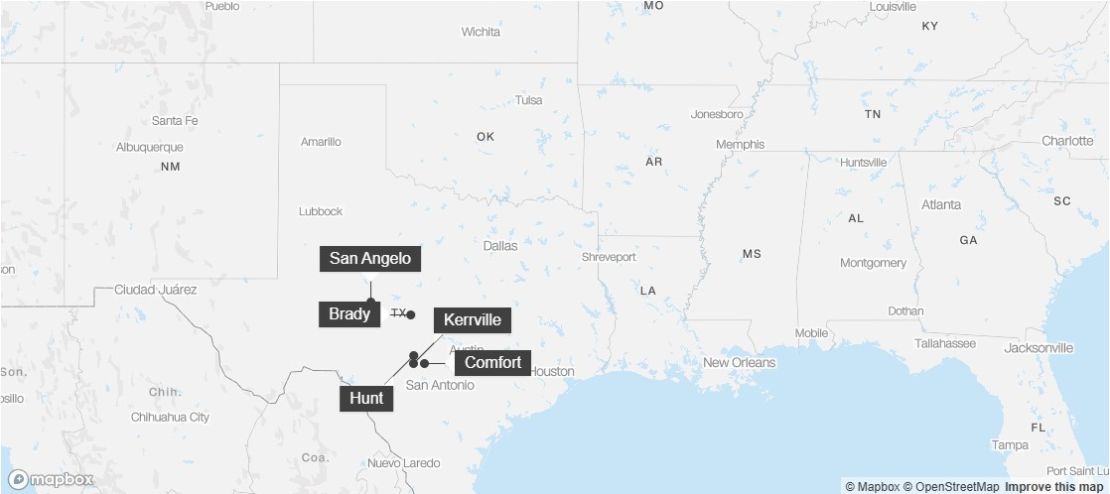At least 24 people died in Kerr County, Texas, after severe flooding hit the state on Friday, Sheriff Larry Leitha said at a news conference Friday night.
In addition, between 23 and 25 girls are missing from Camp Mystic following severe flooding in the region, authorities reported Friday.
Camp Mystic is a private Christian girls’ camp that houses about 750 children in total, Texas Lt. Gov. Dan Patrick said during a news conference Friday.
“That doesn’t mean they’re lost; they could be in a tree, they could be cut off,” he said.
At least 14 helicopters, 12 drones, and more than 500 personnel from various units are working to rescue adults and children near Camp Mystic, Patrick previously said.
Helicopter rescue teams were on standby earlier in the day, but had to wait for weather conditions to improve before safely operating the aircraft, the source added.
“There are still several people missing at this time, but we are working very hard. And we will continue. This process will likely take a couple of days,” Kerr County Sheriff Larry L. Leitha said at a press conference Friday afternoon.
Leitha said he expects more fatalities to be reported in the county.
The search for those swept away by floodwaters in Central Texas will continue overnight as state and local authorities “remain in search and rescue mode,” Texas Gov. Greg Abbott said Friday.
“They will continue into the darkness of the night. They will continue until the sun rises in the morning. They will not stop, seeking to find all those who are still missing,” he said.
First-aid helicopters with infrared technology will be flying overnight in a continued effort to locate potential victims for rescue, according to a source familiar with the search.
“As of a few hours ago, we had rescued or evacuated 237 people, 167 of them by helicopter,” Major General Thomas M. Suelzer said at a press conference Friday night. “So, we’re having a very good helicopter response when weather permits.”
On Saturday, personnel will be deployed to help manage evacuee shelters, and contact tracing efforts will be conducted to confirm the location of those who have been evacuated to date, he added.
Separately, Abbott said Friday he had issued a disaster declaration following severe flooding in the state.
The declaration was issued for several of the hardest-hit counties in Central Texas. It will ensure that counties “will have access to all the tools, strategies, and personnel that the State of Texas can provide, which will be unlimited,” he stated.
“We will put everything we have into the entire state,” Abbott said.
US President Donald Trump called the flooding in Texas “terrible” and promised federal support in the aftermath of the disaster.
“It’s terrible. The floods? It’s shocking. They don’t know how many people yet, but it looks like some young people have died,” Trump told reporters aboard Air Force One while traveling to his club in New Jersey.
When asked if there would be federal aid, he replied, “Oh yeah, we’ll take care of them. We’re working with the governor. We’re working with the governor. It’s a terrible thing.”
Since Thursday night, widespread rainfall of 4 to 6 inches, with some reports of more than 10 inches, has been recorded from San Angelo to Kerrville, triggering multiple flash flood emergencies as the July 4th holiday weekend begins.
A flash flood emergency is the most severe form of flood warning, and the National Weather Service (NWS) has issued at least five since 4 a.m. local time in parts of Tom Green, Kerr, and Kendall counties. San Angelo, with a population of nearly 100,000, is located in Tom Green County.

This is another example of how torrential rains are becoming more frequent in a warming world, as rising global temperatures push weather conditions to extremes. Texas has already suffered multiple dangerous floods this year, and last year, the United States as a whole saw a record number of flash flood emergencies.
The San Angelo Police Department issued an alert warning the public to “stay indoors and avoid travel” and to “shelter in place downtown.”
Police and firefighters in Kerrville, Kerr County, are working on flood rescue efforts, a city official told CNN.
Two parks in Kerrville are closed due to flooding, the city confirmed on social media. Evacuations were underway after water reached the cabins rented by visitors at Kerrville-Schreiner Park around dawn on Friday.
More than an entire summer’s worth of rain fell in some places in just a few hours, rapidly inundating dry soils and causing significant flash flooding. Central Texas is currently experiencing one of the worst droughts in the United States, and completely dry soils flood very quickly.
Water level measurements along portions of the Guadalupe River near the community of Hunt in Kerr County “indicate a large and deadly flood wave is moving downstream,” the NWS warned. The river rose 6.7 meters in just three hours and reached its second-highest level on record early Friday morning. A few hours later, the river gauge that recorded that rise was damaged and out of service due to flooding, according to the National Weather Service in Austin.
San Angelo typically records about 1 inch of rain during July, but reports of overnight rainfall in the city range from 2 inches to over 10 inches.
Hunt, near Kerrville, received about 6.5 inches of rain in just three hours early Friday morning, which is considered a once-in-100-year rainfall event in the area, meaning it has a roughly 1 percent chance of occurring in any given year.
A recent study found that hourly rainfall has intensified in nearly 90% of major U.S. cities since 1970. This is just one of countless dangerous weather events occurring more frequently amid global warming due to fossil fuel pollution.
CNN meteorologists Briana Waxman, Brandon Miller, Gene Norman, and David Williams contributed to this report. CNN ‘s Laura Sharman, Dalia Faheid, Josh Campbell , and Taylor Romine contributed to this report.
